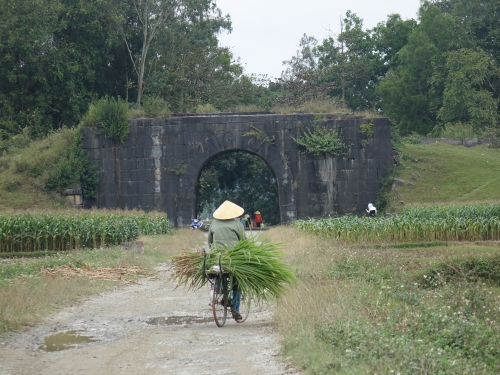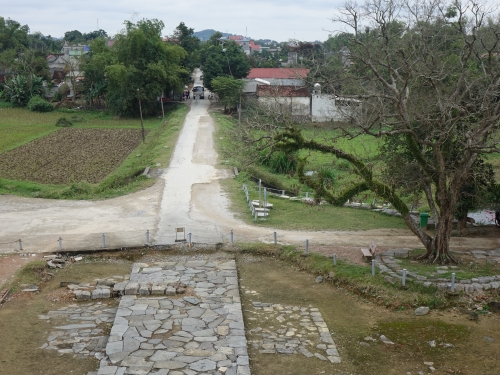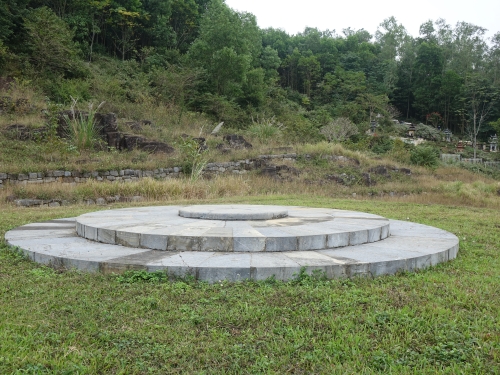Blog WHS Visits
WHS #691: Ho Citadel
The Citadel of the Ho Dynasty comprises the remains of a late 14th-century capital of Vietnam, built in full harmony with its surroundings following the neo-Confucian tradition. Most information that you will find about the site will be accompanied by a picture of that one iconic stone gate: the South Gate of the Citadel. But there is more to this than just “walls and gates”. The WHS consists of 3 locations around the small city of Vinh Loc: the Citadel, the Nam Giao Altar and a part of the Outer Wall. At least 6 of the 7 reviewers before me seem to only have visited the Citadel and then often even just its South Gate. I knew I had to put more effort into it to prevent a short and unsatisfying visit.

From Tam Coc where I was staying overnight, I hired a car + driver to take me to Vinh Loc. It’s only a 58km drive but it took us 1.5 hours because of the heavy traffic and the slow passages through towns of all sizes. Already some 18km before Vinh Loc the WHS is advertised on road signs. In the town itself there are no obvious signs anymore pointing to the citadel, but fortunately my driver had been there before and drove straight to it.
There’s an entrance fee of 40,000 dong (ca. 1.5 EUR) and there were some 20-30 other visitors, mostly locals with children. I started my tour at the visitor center, which has a small exhibition of findings from the WH area. Lots of red tiles, nails, coins, some pottery and a quite magnificent Phoenix that once adorned the roof of a Ho Palace. I also bought a booklet there about the Nam Giao Altar. The text came in both English and Vietnamese, which would later prove to be handy for practical reasons as well. The iconic South Gate is the main entrance to the citadel. It can be climbed via a stairway - and that was what most visitors were doing (taking pictures of their loved ones standing on top of the gate).
Behind the gate the large inner area of the citadel opens up. It is a square of 1x1km. All 4 cardinal directions still have their original gates and the citadel is fully encircled by a wall. As others have noticed the interior is now in use as agricultural land, which does give you some ´couleur locale´ to look at while walking the long stretch to the other end of the citadel. Only a pair of stone dragons about half-way remains of the original setting.

The citadel used to be connected by an Imperial Way to the most sacred place of the capital, Mount Don Son with the Nam Giao altar. Visually, the connection from the South Gate is still there but the stone road has long been replaced by tarmac. To reach the Nam Giao Altar we used my just acquired booklet to ask passers-by for directions. It took us three tries, but we found it: first drive or walk from the citadel in the direction of the landmark Don Son, some 2km away on the other side of Vinh Loc town. The main road splits right before the mountain: take the right loop. After about 500m you will see signs pointing to the left, where you can find the entrance road to the Nam Giao altar. The site lies some 700m further at the end of this road, on a dead end street to the right.
The Nam Giao altar is the place where - according to the Confucian tradition - Heaven and Earth met and the king annually prayed for the prosperity of his people, his dynasty and the state. This altar was only unearthed in 2004, after being unused for almost 6 centuries. I don’t think the site was officially open, but the guard directed us straight through the shrubs uphill to the altar. The official entrance has a stone footpath and even an exhibition room, but the fence over there (with neat Unesco logos!) was locked. The altar consists of a succession of 5 rectangular plateaus that gradually become narrower upwards. Completely on top is a round altar that represents Heaven. On the right side of the path to the altar is a large stepwell in which the king cleansed himself before starting the rituals.

Although I enjoyed my half-day tour to this still nicely off-the-beaten-track area, I still am doubtful whether the Ho Citadel should ever have become a WHS: its short-lived state as capital of Vietnam is no match for the already inscribed Thang Long and Hué & its Vietnamese adaptation of Chinese Confucian city planning is very much a regional niche aspect. There are similar sites on the List as well: Vat Phou with its processional walkway, Hué with its own (though later) Nam Giao Altar and even the Jongmyo Shrine.
Els - 2 January 2019